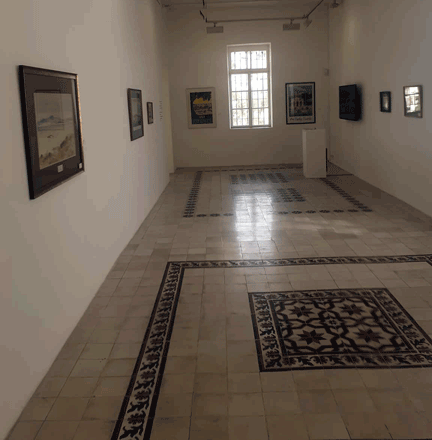You are here
Collector analyses depiction of Holy Land under Ottomans by cartographers, travellers
By Saeb Rawashdeh - Jul 01,2017 - Last updated at Jul 01,2017

‘Jerusalem the Holy City’ from Georg Braun and Franz Hogenberg, Hierosolyma Urbs sancta, 1572 (Photo courtesy of Hisham Khatib)
AMMAN — The former minister of water, energy and planning Hisham Khatib is also a collector of historical maps, manuscripts, photographs and paintings related to the Ottoman period in the Holy Land.
For decades, Khatib has been collecting a large number of items made by Western and Ottoman travellers and cartographers.
One of them, Pierre Jacotin, was a French cartographer who arrived to Palestine with Napoleon’s army in 1798, Khatib said.
“He made the most scientific cartographic recording of the Holy Land at that time in his atlas,” he stressed, adding that the atlas title includes one of the maps of Palestine; five of the topographical and one of the geographical maps were about Palestine, while the rest out of 46 maps depicted Egypt.
“‘Description de l’Égypte; Atlas Topographique’ is one of the most important works in the 19th century French cartography,” the collector emphasised, noting that Napoleon forbade the publication of the atlas for security reasons, although Jacotin, the colonel in charge of the topographical section of the French army at that time, prepared it for publication in 1807.
It was finally published together with the monumental text volumes of the “Description de l’Egypte”, embodying the scientific results of Napoleon’s expedition to Egypt, Khatib continued, noting that the atlas maps the region of modern Egypt, parts of Sudan, Libya and Palestine, for the first time by triangulation and topographic survey, with reliefs shown by hachures.
“It was the most advanced cartography at that time,” Khatib said.
The lack of security was one of the main reasons the interest of European explorers in the southern Levant decreased between the end of Crusades in the 13th century and the beginning of the 19th century, he claimed.
“There was a lack of security, mainly because of bedouins, marauders and brigands, so no traveller could venture outside of the main cities. Therefore, this is the main reason for the poor recording of the Holy Land during that period,” Khatib explained.
Most of the travellers were interested in biblical narrative and in finding actual proofs on the ground, he underscored, noting that many of their recordings were not scientific and that they mainly ignored local people and concentrated on their interpretation of the biblical stories.
Whenever they related to the local situation, it was in negative terms and, apparently, there was not enough attention paid by the Ottomans to the Holy Land and its population in the early Ottoman period, the scholar underlined.
“Things started to improve only in the late 19th century and after the Tanzimat [Reforms of the Ottoman Empire],” he noted.
Unfortunately, “museums run by Palestinian and Jordanian institutions do not care enough about this heritage”, the collector claimed, saying that it is due to the shortage of expert curators and independent researchers.
“Very few local scholars are interested in undertaking research into this period,” he stressed, adding that “ those who do are influenced by emotions and try to look at that period in a more favourable view than it actually was”.
Independent scholar research with devotion and integrity is “new to our local community” and not yet entrenched, Khatib said.
“It needs devotion, thorough command of English and very hard work. Most of the research done in local universities, which is limited, is devoted to the Ottomans’ heritage, mainly in the records of Mahkem Sharieh [because it is of local importance]. This is not enough,” he underlined.
According to Khatib, there is a need to concentrate on different cultures and trends, and to fully understand and record the Holy Land during the Ottoman period in all its aspects.
Things are improving, but slowly, he continued,”We need devoted institutions. Rich Palestinians and Arabs are locating some of their collections to research centres outside the Arab world, because of the lack of the local interest, as well as the shortage of devoted curators.”
Another problem for collectors in Jordan is found with “bureaucrats at the postal and custom departments, who tend to complicate the process” of importing these cultural items back into the country, although they represent a national wealth, Khatib complained.
“Whereas other countries assist and pay generously for the retrieval of their heritage back into their countries, we make it most difficult by customs, duties and misunderstanding,” Khatib concluded.
Related Articles
AMMAN — Hisham Khatib was a Renaissance man — an expert in energy, economy, art history and political history of the Levant.
AMMAN — Although Hisham Khatib has a career spanning 50 years in the energy sector, the former minister has also found the time to dedicate
CAIRO — Napoleon Bonaparte’s bloody campaign in Egypt and Palestine, which marked the start of modern European colonialism in the Middle Eas

















